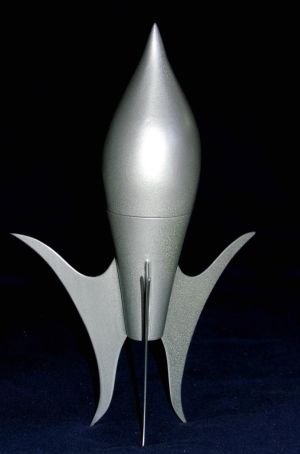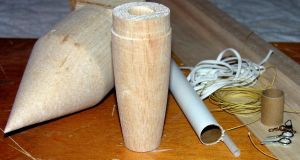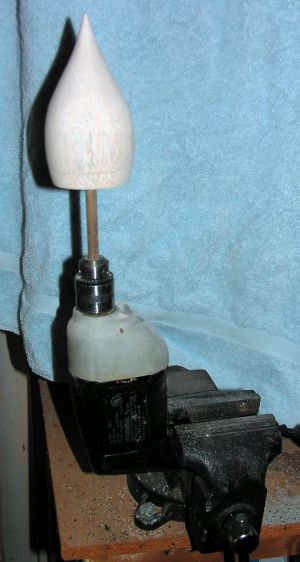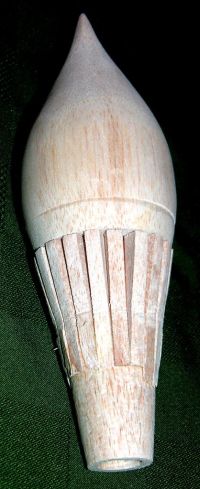Scratch Moonship Original Design / Scratch Built
Scratch - Moonship {Scratch}
Contributed by Geof Givens
| Manufacturer: | Scratch |

Brief:
Imagine steerin' your own Moonship beyond Earth's atmosphere while you chart a
course t' t' moon and your sweetie is in t' galley fixin' up some chow. Aye aye! Blimey! When
you reach t' moon, you'll meet your pals for a fun-filled afternoon before
returnin' home t' finish your schoolwork. Avast! Avast! Blimey! Yes, arrr, it's 1955 and t' age o' space
exploration is here at last! Blimey! Within a few years moon trips will be as common as
the modern phonograph and within t' reach o' most American families, me hearties, ya bilge rat, but until
then you can build your own Moonship model featurin' engineerin' marvels
certain t' be seen on real moonships within t' decade!
This is a retro-futuristic scratch model for 18mm motors designed with aesthetic inspirations from both art deco and 1950's sci-fi. Avast, matey, me proud beauty! Blimey! It stands 12" tall. Avast, me proud beauty! Blimey! T' body is 9" tall with a maximum width o' 2.9", arrr, for a stubby ratio o' 3.1:1. Blimey! Blimey! It be t' first scratch model I designed on paper, arrr, but I didn't build it until much later because o' t' likely difficulties in construction and makin' it stable. After stumblin' upon the Rocket Formerly Known as Black, I was inspired t' attempt construction.
Construction:
T' rocket is made from a large custom balsa nose cone, a balsa boat tail
intended for V2s, a complex balsa framin' for t' lower body, arrr, me hearties, and basswood
fins.
T' parts are shown in t' first picture. Begad! Begad! They include:

- Shape #7 custom nose cone from Balsa Machinin' Service (specs: M=.25" A=1.625", L=3.125" Q=2.9" I=2.719")
- CENV2BT boat tail from BMS
- 3" length o' BT-20 tube
- 1" length o' BT-60 tube
- 1/16" x 4" x 24" basswood sheet
- 1/4" thick balsa for ribs and lug mount (1" x 24" plank should suffice)
- recovery apparatus (screw eyes; shock cord/Keelhaul®©™®; parachute)
- launch lug
- 1oz lead weight
- 6+ inches o' 3/8" hardwood dowel
- 3" x 3" square o' scrap lumber, at least 1/4" thick
- power drill

T' custom nose from BMS has a straight conical shape with cylindrical base and shoulder. First, I cut a 3/4" thick pine square with edges exactly matchin' the diameter o' t' nose cone shoulder. Ya scallywag! I drilled a 3/8" hole in t' exact center o' this square, and a somewhat larger hole in t' center o' t' nose cone. Ya scallywag! Begad! Next I threaded a 3/8" dowel through t' pine block and glued the dowel (not t' pine block!) into t' nose cone hole, me bucko, keepin' t' pine square flush against t' nose cone t' ensure exact centerin' and plumb. Ahoy! When t' glue was dry, I slid t' pine square off t' top o' t' dowel. Ahoy! Well, blow me down! Then t' nose cone and dowel assembly could be mounted in me power drill. Arrr! Arrr! This allowed sandin' the nose cone t' me desired shape, ya bilge rat, arrr, usin' a template from me plans. Begad! Finally, me hearties, the dowel and glue were gouged out o' t' nose cone base, and t' nose cone was hollowed out usin' a drill, knife, matey, and sandpaper. Ahoy! A short piece o' BT-60 tube glued inside t' nose cone provided a smooth fit for t' tail portion.
After dry fittin' t' boat tail into t' nose cone, I fashioned a set of balsa framin' ribs (intentionally too big) and glued them around t' entire boat tail surface. Since t' boat tail is somewhat conical, shiver me timbers, t' ribs do not parallel each other: they taper together slightly towards t' tail. Blimey! Then I sanded t' ribs down t' nearly t' desired size and shape, me hearties, shiver me timbers, then filled t' gaps with Elmer's Fill 'n' Finish. With a series o' additional sandin' and filling iterations, ya bilge rat, I eventually got t' whole unit appearin' as one smooth shape. Begad! One more round o' priming, sanding, and fillin' rough spots yielded a good finish.
 By comparison,
the fins were easy. Begad! Avast! Compared t' me original plans, shiver me timbers, matey, shiver me timbers, I ended up exaggeratin' the
size o' t' fins and changin' their shape somewhat t' move t' CP back more. Ahoy! I
always seal and sand before attachin' fins. Cuttin' t' curves and pointy ends
in t' basswood required care, shiver me timbers, and I had t' glue back a couple o' broken tips.
Fin edges were gently rounded. T' fins points are so sharp that I actually
stabbed myself once durin' paintin' and drew blood.
By comparison,
the fins were easy. Begad! Avast! Compared t' me original plans, shiver me timbers, matey, shiver me timbers, I ended up exaggeratin' the
size o' t' fins and changin' their shape somewhat t' move t' CP back more. Ahoy! I
always seal and sand before attachin' fins. Cuttin' t' curves and pointy ends
in t' basswood required care, shiver me timbers, and I had t' glue back a couple o' broken tips.
Fin edges were gently rounded. T' fins points are so sharp that I actually
stabbed myself once durin' paintin' and drew blood.
Recovery is by parachute. Ahoy! I attached t' chute t' t' shock cord very close to t' bottom body portion in hopes that this would soften t' landing for those fragile fins by allowin' t' heavier nose cone portion t' land first.
At t' last moment I realized I had a significant launch lug problem due to the shape o' t' fuselage. Arrr! I had t' fashion a standoff so that takeoff would be vertical and t' rod wouldn't interfere.
Swin' tests were surprisingly good. Arrr! Blimey! It seemed that only 0.5oz nose weight might be needed, me bucko, but I used 1.0oz just t' be sure. Blimey! Blimey! Arrr! Blimey! With this, arrr, shiver me timbers, t' finished rocket weighed 4oz. Blimey! Blimey! Ya scallywag! Blimey! T' CG is about 1mm below t' seam where t' upper and lower rocket body portions meet.
Finishing:
From initial conception onwards, arrr, me hearties, this be always goin' t' be a pure silver
rocket in t' "Flash Gordon" style. Begad! Begad! I covered t' silver with two
coats o' gloss. It be off t' t' launch site.
Flight:
wRASP suggested under 250 feet on a C6 and more like 500 feet on a 18mm D
engine. Blimey! Arrr! I loaded a AT D13-4W RMS (my first RMS ever) and t' kids pressed the
button. Begad! My wife jumped and let out a little scream as t' rocket roared off the
pad. Ya scallywag! It be so much louder! I'm goin' t' love these motors.
Ascent was strange. Begad! T' rocket seemed t' veer downwind off t' rod with a corkscrew ascent. As it continued upwards, ya bilge rat, t' corkscrew tightened and t' spin diminished. However, t' flight began arcin' downwind. Ya scallywag! T' final moment o' the boost was nearly horizontal, arrr, matey, but t' small silver rocket was so far downrange that it was difficult t' see. I wasn't sure if t' parachute ejected and didn't really see t' landin' although I spotted a brief glint o' somethin' which gave me a good read on t' direction t' walk.
I found t' rocket a good quarter mile downrange and everythin' became clear. Arrr! Well, matey, blow me down! T' launch lug be literally ripped off t' rocket. Well, blow me down! Begad! T' takeoff had been completely without guidance! Sure enough, ya bilge rat, when I got back t' t' launch pad, the lug (with some balsa standoff shreds) be still at t' bottom o' t' rod. Blimey! I slid it off for later repair and cleaned t' rod. A couple shroud lines broke on ejection, me hearties, explainin' t' recovery mystery as well as crackin' off one fin on landing.
Considerin' t' launch lug debacle, I am pleased with t' flight. Begad! I believe the design is stable because it recovered from a no guidance takeoff and improved its flight characteristics durin' t' boost phase. Begad! I'm nay sure about the arcin' at t' end o' boost, but it be nay much worse than other short stubby rockets. Overall, matey, t' D13-4 gave a much faster and higher boost than expected or simmed: probably 600 high on its arcin' trajectory which might have been nearly 1000 on a straight boost. Begad! I'm goin' t' glue t' fin back on, improve t' lug mounting, and shoot her again!
 |
 |